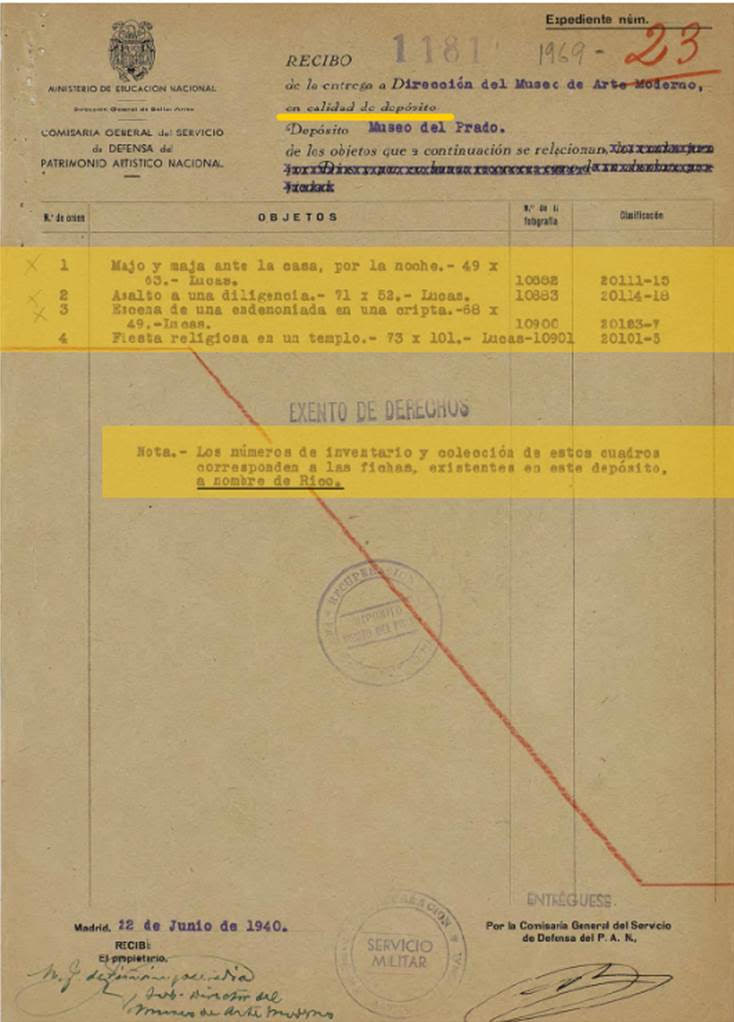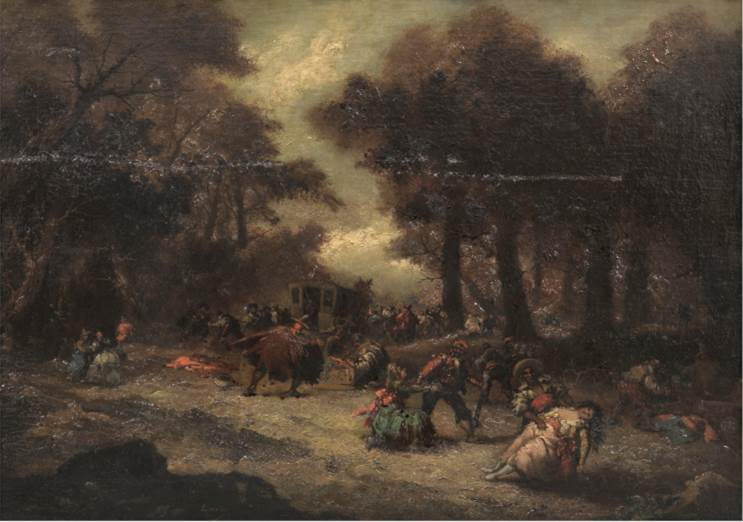The following guest blog post was written by Andrea Martín Alacid.
 Following other European museums such as the Musée du Louvre in Paris and the British Museum in London, Museo Nacional del Prado (the Prado) in Madrid recently announced a new initiative. It would carry out an ex officio review of its collection to identify works of art seized during the Spanish Civil War and Franco’s regime by the Board of Seizure and Protection of Artistic Heritage founded in 1936 (and known as the Board of Artistic Treasure from 1937 onwards). Following the museum’s initiative, 25 documented works that were never returned to their rightful owners have been identified so far, but there is no doubt that this number could increase.
Following other European museums such as the Musée du Louvre in Paris and the British Museum in London, Museo Nacional del Prado (the Prado) in Madrid recently announced a new initiative. It would carry out an ex officio review of its collection to identify works of art seized during the Spanish Civil War and Franco’s regime by the Board of Seizure and Protection of Artistic Heritage founded in 1936 (and known as the Board of Artistic Treasure from 1937 onwards). Following the museum’s initiative, 25 documented works that were never returned to their rightful owners have been identified so far, but there is no doubt that this number could increase.
In response, the Prado has commissioned Professor Emeritus Arturo Colorado Castellary to lead a research project at the museum with the aim of clarifying the provenance of some of its works. His research will examine the background and context in which the works entered the Prado’s collections, in order to promote transparency and (if necessary and in compliance with all legal requirements) return them to their rightful owners. Professor Colorado is expected to share the first results of his research in early 2023.
 Following the Prado’s announcement and after a great deal of research, this initiative has already borne fruit. The heirs of Pedro Rico López (a lawyer and Republican politician, as well as the mayor of Madrid in the 1930s), have begun the restitution process for the at least 25 paintings thus far. It was not until February 2021 that López’s grandchildren first learned about the whereabouts of their family’s artworks. The works were seized during the post-war period. The heirs eventually learned of the seized assets from an article, El botín del patrimonio español que el franquismo repartió en la posguerra (The spoils of Spanish heritage that Franco´s regime distributed in the post-war period), published in the Spanish national newspaper ABC, after Arturo Colorado’s research came to light . The heirs retained Spanish art law firm Caliope Art Law Boutique, founded by Laura Sánchez Gaona, to set forth their claim.
Following the Prado’s announcement and after a great deal of research, this initiative has already borne fruit. The heirs of Pedro Rico López (a lawyer and Republican politician, as well as the mayor of Madrid in the 1930s), have begun the restitution process for the at least 25 paintings thus far. It was not until February 2021 that López’s grandchildren first learned about the whereabouts of their family’s artworks. The works were seized during the post-war period. The heirs eventually learned of the seized assets from an article, El botín del patrimonio español que el franquismo repartió en la posguerra (The spoils of Spanish heritage that Franco´s regime distributed in the post-war period), published in the Spanish national newspaper ABC, after Arturo Colorado’s research came to light . The heirs retained Spanish art law firm Caliope Art Law Boutique, founded by Laura Sánchez Gaona, to set forth their claim.
As a result of the research carried out by the due diligence department of the law firm, along with the information provided by the Spanish General Directorate of Fine Arts, led by Isaac Sastre de Diego, the current location of 23 of the family’s artworks in various Spanish museums was discovered. In September 2021, members of the Caliope Art Law Boutique accompanied one of the heirs to identify the three Eugenio Lucas paintings in the custody of the Prado. The heirs had previously never seen these works in person. Although this was just a first step, it was an emotional moment for all those present, including Andrés Úbeda de los Cobos (Deputy Director of Conservation and Research) and Carlos Chaguaceda (Director of Communications) working on behalf of the Prado. While viewing the three paintings, it was noted that the Prado kept the Seizure Board’s labels intact. This is most valuable as the label recorded the name of the works’ rightful owner, Pedro Rico.
 The paintings currently held by the Prado, together with the other works documented, have been in the possession of different administrations for a number of decades. Under the law of adverse possession in the Spanish Civil Code, the museums are considered the legal owners. However, the State Attorney General’s Office has recently reevaluated this doctrine in the context of plundered works of art. As a result, the first restitution of a work of art seized during the Civil War took place last month. The recipients are the family of Ramón de la Sota Chalbaud, and the work in question is Portrait of a Young Gentleman by Cornelis can der Voort. This landmark restitution has paved the way for new cases to come.
The paintings currently held by the Prado, together with the other works documented, have been in the possession of different administrations for a number of decades. Under the law of adverse possession in the Spanish Civil Code, the museums are considered the legal owners. However, the State Attorney General’s Office has recently reevaluated this doctrine in the context of plundered works of art. As a result, the first restitution of a work of art seized during the Civil War took place last month. The recipients are the family of Ramón de la Sota Chalbaud, and the work in question is Portrait of a Young Gentleman by Cornelis can der Voort. This landmark restitution has paved the way for new cases to come.
In short, there is no doubt that this initiative by the Prado, together with the re-evaluation of adverse possession, is a crucial and significant step in the restitution procedures of looted cultural heritage in Spain, which unfortunately lack a specific legal framework at this time. It is likely that this framework will be developed in the near future, and we eagerly await ongoing developments.
We congratulate our esteemed colleagues and friends in Spain for their remarkable work fighting for justice and paving the way for equitable restitutions in Europe.